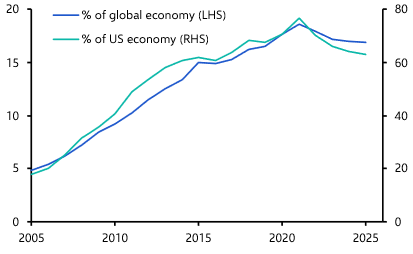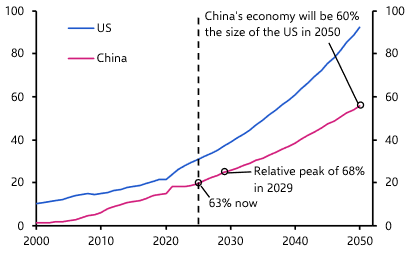- A weak currency and sustained deflation mean that China’s economy is on course to shrink as a share of the global economy for a fourth consecutive year, when measured at market exchange rates. China has gone from more than three quarters the size of the US in 2021 to under two thirds today. (See Chart 1.) Real growth remains stronger in China than the global average. But the era in which China’s share of global output was surging has ended. This will limit China’s capacity to project economic power in future.
- One consequence of the recent pullback is that China’s economy is barely any bigger relative to the US now (63% the size in 2025) than it was a decade ago (62%), according to IMF data. That’s something few would have predicted in 2015. China has gone from 15% to 17% of the global economy since 2015. By contrast, China’s share tripled from 5% in the preceding decade.
|
Chart 1: Size of China’s Economy Relative to the US & the World |
|
|
|
Sources: IMF, Capital Economics |
- Real GDP growth has remained consistently stronger in China than in the US or than the global average over the past decade, both on the official GDP measure and on our China Activity Proxy (other than in 2022, when the CAP shows that China’s growth stalled as zero-COVID policies led to lengthy lockdowns in Shanghai and other cities).
- Living standards are rising faster in China too. Purchasing power parity GDP is a better measure of living standards than GDP at market exchange rates. The IMF expects PPP per capita GDP in China to reach 33% of the US level this year, from 29% in 2021 and 23% in 2015.
- But GDP at market exchange rates is the better gauge of a country’s ability to project economic power since goods are purchased and investments made at market exchange rates. Around half of China’s relative decline at market exchange rates is due to the renminbi’s depreciation against the dollar over the past few years. The rest is the result of domestic deflation: China’s official GDP deflator has been negative for 11 consecutive quarters. The outcome is that even though China’s economy has been growing faster in real terms, growth in the value of its output at market exchange rates has lagged the US.
- These drags from falling prices and the exchange rate may not persist. Indeed, economic theory suggests that deflation – which we do expect to continue – should result in an offsetting currency appreciation. The renminbi does seem to have turned a corner: it is likely to end this year stronger against the dollar than it started for the first time since 2021, and we expect further small gains in the next couple of years. On both the IMF’s forecasts and our own, a currency rebound will help China recover some lost ground against the US over the next few years. (Clients can view and download our long-run forecasts here).
- But a slower pace of real economic growth is likely to cap China’s catch-up as it enters the 2030s. Our longstanding forecast is that weaker productivity growth and demographic decline will slow China’s real growth rate to 2% by 2030 (China’s workforce is likely to be 8% smaller in 2040 than it is today, and the US workforce 5% bigger). One consequence is that, while China climbed from 11% to 63% the size of the US between 2000 and 2025, on our projections, China will reach 2050 no bigger relative to the US than it is today. (See Chart 2.)
|
Chart 2: CE Projections for Nominal GDP |
|
|
|
Sources: IMF, Capital Economics |

